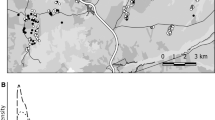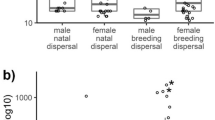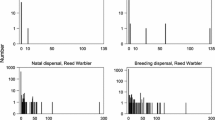Abstract
We studied movements of individually marked greater flamingos (Phoenicopterus ruber roseus) born in the Camargue, southern France, between their two most important breeding colonies in the western Mediterranean (Camargue and Fuente de Piedra, Spain) from 1986 to 1992. The two sites differ in the frequency with which they offer suitable conditions for breeding. Flamingos have bred each year in the Camargue since 1974, but in only 12 of the past 22 years at Fuente de Piedra. Higher colony fidelity is thus expected in the less variable environment (Camargue), but if dispersal occurs competition might be an important factor causing this dispersal. Following years during which breeding birds in the Camrgue were disturbed (1988 and 1990) a higher proportion of adults changed colonies between breeding attempts (= breeding dispersal, 12.4%), while only 0.4% of flamingos breeding in the Camargue dispersed in the other years. As expected, flamingos breeding at Fuente de Piedra showed a higher rate of breeding dispersal (8.14%). No differences were observed between males and females. The importance of breeding failure as a factor causing breeding dispersal in flamingos was also confirmed by the movements of individual birds. The proportion of young flamingos that moved from their natal colony to start breeding at Fuente de Piedra (= natal dispersal) was independent of sex and age, but increased when breeding access to the Camargue colony was more difficult. However, natal dispersal was also higher in 1988 and 1990 (40.5%) than in the remaining years (1.2%), as was breeding dispersal. We discuss possible ways in which the increased natal dispersal among inexperienced birds could be linked with the increased breeding dispersal of adults in the same year.
Similar content being viewed by others
References
Aebischer NJ (1995) Philopatry and colony fidelity of shags Phalacrocorax aristotelis on the east coast of Britain. Ibis 137: 11–18
Andersson M (1980) Nomadism and site tenacity as alternative reproductive tactics in birds. J Anim Ecol 49: 175–184
Arcese P (1989) Intrasexual competition, mating system and natal dispersal in song sparrows. Anim Behav 38: 958–979
Areese P, Smith JNM, Hochachka WM, Rodgers CM, Ludwig D (1992) Stability, regulation, and determination of abundance in an insular song sparrow population. Ecology 73: 805–822
Baeyens G (1981) Functional aspects of serial monogamy: the magpie pair bond in relation to its territorial system. Ardea 69 145–166
Beletsky LD, Orians GH (1978) Territoriality among male red-winged blackbirds. I. Site fidelity and movement patterns. Behav Ecol Sociobiol 20: 21–34
Bensch S, Hasselquist D (1991) Territory infidelity in the polygynous great reed warbler, Acrocephalus arundinaceus: the effect of variation in territory attractiveness. J Anim Ecol 60: 857–871
Blancher PJ, Robertson RJ (1985) Site consistency in kingbird breeding performance: implications for site fidelity. J Anim Ecol 54: 1017–1024
Boy V (1981) Analyses statistiques sur micro-ordinateur. J Assoc Stat Univ 6: 71–73
Brooke M de L (1978) The dispersal of female manx shearwaters, Puffinus puffinus. Ibis 120: 545–551
Brooke M de L (1979) Differences in quality of territories held by wheatears, Oenanthe oenanthe. J Anim Ecol 48: 21–32
Catchpole CK (1972) A comparative study of territory in the reed warbler, Acrocephalus scirpaceus, and sedge warbler, A. schoenobaenus. J Zool Lond 166: 213–231
Cézilly F, Gowthorpe P, Lamarche B, Johnson AR (1994) Observations on the breeding of the greater flamingo, Phoenicopterus ruber roseus, in the Banc d'Arguin National Park, Mauritania. Colon Waterbirds 17: 181–183
Cézilly F, Boy V, Green RE, Hirons GJM, Johnson AR (1995) Interannual variation in greater flamingo breeding success in relation to water levels. Ecology 76: 20–26
Cézilly F, Viallefont A, Boy V, Johnson AR (1996) Inter-annual variation in survival and breeding probability among greater flamingos of known age and sex. Ecology (in press)
Chabrzyk G, Coulson JC (1976) Survival and recruitment in the herring gull, Larus argentatus. J Anim Ecol 45: 187–203
Clarke AB (1978) Sex ratio and local resource competition in a prosimean primate. Science 201: 163–165
Clobert J, Perrins CM, McCleery RH, Gosler AG (1988) Survival rate in the great tit, Parus major, in relation to sex, age and immigration status. J Anim Ecol 57: 287–306
Clutton-Brock TH, Harvey PH (1976) Evolutionary rules and primate societies. In: Bateson PPG, Hinde RA, (eds) Growing points in ethology. Cambridge University Press, Cambridge, pp 195–237
Clutton-Brock TH, Albon SD, Guinness FE (1982) Competition between female relatives in a matrilocal mammal. Nature 300: 178–180
Comins HN, Hamilton WD, May RM (1980) Evolutionary stable dispersal strategies. J Theor Biol 82: 205–230
Cramp S, Simmons KEL (eds) (1977) The birds of the Western Palearctic, vol 1. Oxford University Press, Oxford
Crawley MJ (1992) GLIM for ecologists. Blackwells, Oxford
Dow H, Fredga S (1983) Breeding and natal dispersal of the goldeneye, Bucephala clangula. J Anim Ecol 52: 681–695
Emlen ST, Oring LW (1977) Ecology sexual selection and the evolution of mating systems. Science 197: 215–223
Fretwell SD (1972) Populations in a seasonal environment. Princeton University Press, Princeton
Fretwell SD, Lucas HJ Jr (1970) On territorial behaviour and other factors influencing habitat distribution in birds: Acta Biotheor 19: 16–36
Frith HJ (1967) Waterfowl in Australia. Angus and Robertson, Sidney
Gaines MS, McClenaghan LR Jr (1980) Dispersal in small mammals. Annu Rev Ecol Syst 11: 163–196
Gallet E (1950) The flamingos of the Camargue. Blackwells Oxford
Galushin VM (1974) Synchronous fluctuations in populations of some raptors and their prey. This 116: 127–134
Green RE, Hirons GJM (1988) Effects of nest failure and spread of laying on counts of breeding birds. Ornis Scand 19: 76–78
Green RE, Hirons GJM, Johnson AR (1989) The origin of long-term cohort differences in the distribution of greater flamingos, Phoenicopterus ruber roseus, in winter. J Anim Ecol 58: 543–555
Greenwood PJ (1980) Mating systems, philopatry and dispersal in birds and mammals. Anim Behav 28: 1140–1162
Greenwood PJ, Harvey PH (1976) The adaptive significance of variation in breeding area fidelity of the blackbird, Turdus merula L. J Anim Ecol 45: 887–898
Greenwood PJ, Harvey PH (1982) The natal and breeding dispersal of birds. Annu Rev Ecol Syst 13: 1–21
Haartman L von (1949) Der Trauerfliegenschnäpper. I. Ortstreue und Rassenbildung. Acta Zool Fenn 56: 1–104
Hamilton WD, May RM (1977) Dispersal in stable habitats. Nature 269: 578–581
Harvey PH, Greenwood PJ, Perrins CM (1979) Breeding area fidelity of great tits, Parus major. J Anim Ecol 48: 305–313
Harvey PH, Greenwood PJ, Campbell B, Stenning MJ (1984) Breeding dispersal of the pied flycatcher, Ficedula hypoleuca. J Anim Ecol 53: 727–736
Harvey PH, Stenning MJ, Campbell B (1985) Individual variation in seasonal breeding success in the pied flycatcher, Ficedula hypoleuca. J Anim Ecol 54: 391–398
Hastings A (1983) Can spatial variation alone lead to selection for dispersal? Theor Popul Biol 24: 244–251
Hinde RA (1956) The biological significance of the territories of birds. Ibis 98: 340–369
Hoffmann L (1964) La reproduction des Flamants en 1962 et 1963. Revue d'Ecologie (Terre Vie) 18: 331–333
Holt RD (1985) Population dynamics in two-patch environments: some anomalous consequences of an optimal habitat distribution. Theor Popul Biol 28: 181–208
Jakobsson S (1988) Territorial fidelity of willow warbler, Phylloscopus trochilus, males and success in competition over territories. Behav Ecol Sociobiol 22: 79–84
Johnson AR (1983) Etho-écologie du flammant rose (Phoenicopterus ruber roseus Pallas) en Camargue et dans l'Ouest Paléarctique. PhD thesis. University of Toulouse, Toulouse
Johnson AR (1989) Movements of greater flamingos (Phoenicopterus ruber roseus) in the western Palearctic. Rev Ecol Terre Vie 44: 75–94
Johnson AR, Green RE, Hirons GJM (1991) Survival rates of greater flamingos in the west Mediterranean region. In: Perrins CM, Lebreton J-D, Hirons GJM (eds) Bird population studies. Oxford University Press, Oxford, pp 249–271
Johnson AR, Cézilly F, Boy V (1993) Plumage development and maturation in the greater flamingo, Phoenicopterus ruber roseus. Ardea 81: 25–34
Johnson ML, Gaines MS (1990) Evolution of dispersal: theoretical models and empirical tests using birds and mammals. Annu Rev Ecol Syst 21: 449–480
Korpimäki E (1993) Does nest-hole quality, poor breeding success or food depletion drive the breeding dispersal of Tengmalm's owl? J Anim Ecol 62: 606–613
Korpimäki E, Lagerström M, Saurola P (1987) Field evidence for nomadism in Tengmalm's owl, Aegolius funereus. Ornis Scand 18: 1–4
Levin SA, Cohen D, Hastings A (1984) Dispersal strategies in patchy environments. Theor Popul Biol 26: 165–191
McPeek MA, Holt RD (1992) The evolution of dispersal in spatially and temporally varying environments. Am Nat 140: 1010–1027
Mills JA (1973) The influence of age and pair bond on the breeding biology of the red-billed gull, Larus novaehollandiae scopulinus. J Anim Ecol 42: 147–163
NAG (1986) The generalised linear interactive modelling system, release 3.77. The Royal Statistical Society, London
Nelson JB (1966) The breeding biology of the gannet, Sula bassana, on the Bas Rock, Scotland. Ibis 108: 584–626
Newton I (1972) Finches. Taplinger, New York
Newton I (1979) Population ecology of raptors. Poyser, Berkhamstead
Newton I, Marquiss M (1982) Fidelity to breeding area and mate in the sparrow hawk, Accipiter nisus. J Anim Ecol 51: 327–341
Nolan V (1978) The ecology and behaviour of the prairie warbler, Dendroica discolor. Ornithol Monogr 31: 1–595
Ogilvie M, Ogilvie C (1986) Flamingos. Alan Sutton, Gloucester
Ollason JC, Dunnet GM (1978) Age, experience, and other factors affecting the breeding success of the fulmar, Fulmarus glacialis, in Orkney. J Anim Ecol 47: 961–976
Oring LW, Lank DB, Maxson SJ (1983) Population studies of the polyandrous spotted sandpiper. Auk 100: 272–285
Pärt T (1994) Male philopatry confers a mating advantage in the migratory collared flycatcher, Ficedula albicollis. Anim Behav 48: 401–409
Pärt T (1995) The importance of local familiarity and search costs for age- and sex-biased philopatry in the collared flycatcher. Anim Behav 49: 1029–1038
Pärt T, Gustafsson L (1989) Breeding dispersal in the collared flycatcher, Ficedula albicollis: possible causes and consequences. J Anim Ecol 58: 305–320
Payne RB, Payne LL (1993) Breeding dispersal in indigo buntings: circumstances and consequences for breeding success and population structure. Condor 95: 1–24
Pusey AE (1987) Sex-biased dispersal and inbreeding avoidance in birds and mammals. Trends Ecol Evol 2: 295–299
Richdale LE (1957) A population study of penguins. Clarendon Press, Oxford
Roff DA (1975) Population stability and the evolution of dispersal in a heterogeneous environment. Oecologia 19: 217–237
Searcy WA (1979) Female choice of mates: a general model for birds and its applications to red-winged blackbirds, Agelaius phoeniceus. Am Nat 114: 77–100
Shields WM (1982) Philopatry, inbreeding, and the evolution of sex. Albany State University Press, New York
Shields WM (1983) Optimal inbreeding and the evolution of philopatry. In: Swingland IR, Greenwood PJ (eds) The ecology of animal movement. Clarendon Press, Oxford, pp 132–159
Sokal RR, Rohlf FJ (1987) Introduction to biostatistics, 2nd edn. Freeman, New York
Stenzel LE, Warriner JC, Warriner JS, Wilson KS, Bidstrup FC, Page GW (1994) Long-distance breeding dispersal of snowy plovers in western North America. J Anim Ecol 63: 887–902
Studer-Thiersch A (1986) Tafsus length as an indication of sex in the flamingo genus Phoenicopterus. Int Zoo Yb 24/25: 240–243
Vander Wall SB, Hoffman SW, Potts WK (1981) Emigration behaviour of Clark's nutcracker. Condor 83: 162–170
Waser PM (1985) Does competition drive dispersal? Ecology 66: 1170–1175
Waser PM, Jones WT (1983) Natal philopatry among solitary mammals. O Rev Biol 58: 355–390
Weatherhead PJ, Boak KA (1986) Site infidelity in song sparrows. Anim Behav 34: 1299–1310
Weatherhead PJ, Forbes MRL (1994) Natal philopatry in passerine birds: genetic or ecological influences. Behav Ecol 5: 426–433
Wiens JA (1976) Population responses to patchy environments. Annu Rev Ecol Syst 7: 81–120
Wooller RD, Coulson JC (1977) Factors affecting the age of first breeding of the kittiwake, Rissa tridactyla. Ibis 119: 339–349
Zann R, Runciman D (1994) Survivorship, dispersal, and sex-ratios of zebra finches, Taeniophygia guttata, in Southeast Australia. Ibis 136: 136–146
Author information
Authors and Affiliations
Rights and permissions
About this article
Cite this article
Nager, R.G., Johnson, A.R., Boy, V. et al. Temporal and spatial variation in dispersal in the greater flamingo (Phoenicopterus ruber roseus). Oecologia 107, 204–211 (1996). https://doi.org/10.1007/BF00327904
Received:
Accepted:
Issue Date:
DOI: https://doi.org/10.1007/BF00327904




